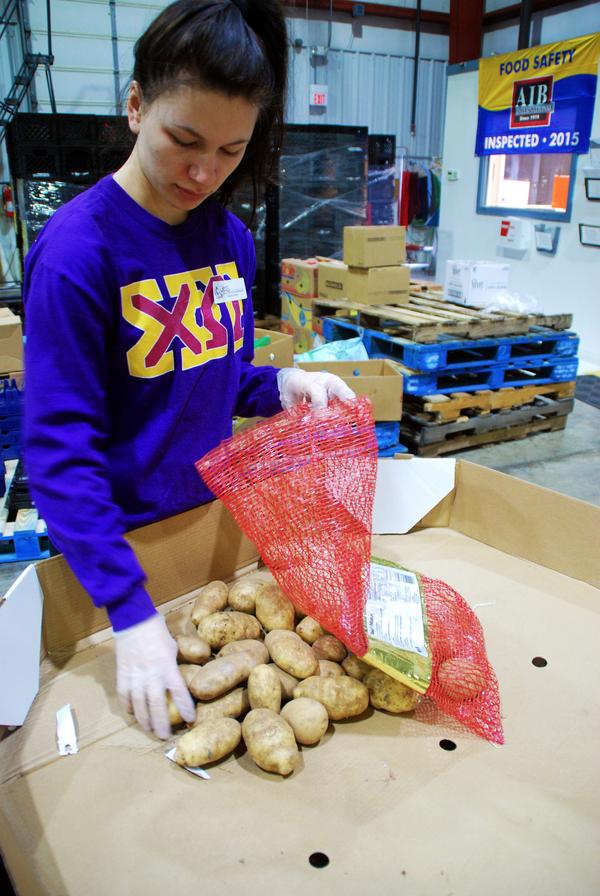University students feel a disconnect with the town they call home for four years
“I accidentally fell in love with this town,” Carolyn Case thought as she tried to figure out her post-grad plans. “I kind of don’t want to leave.”
Throughout her time as an undergraduate and as a graduate student at Ball State University, Carolyn never thought she’d stay in Muncie. She and her fiancé had plans to move away. But she began to second guess everything.
She brought this up to her fiancé. They just recently became members of their church, the cost of living is fairly cheap, they could have a comfortable lifestyle, and they care about the people here. They accidentally put down roots in Muncie. It seemed wrong to leave.
So they decided to stay.
Universities tend to attract two things to a small town: revenue and people. They bring in revenue from outside the immediate area through tuition, endowment income, or state tax allocations and bring in human capital in the form of students and employees, according to a study by the University of Kentucky. All of this contributes to the area’s economic growth. With the large influx of people from outside areas, it’s not atypical for university students to be unfamiliar with the town they call home for four years. This disconnect is known as the town and gown divide.
Carolyn didn’t like to feel the divide between where she lives and where she goes to school, so three years ago, she got involved in the My Muncie campaign, designed to showcase volunteerism in Muncie. After her role with the project ended she thought, “I don’t want to start something then just let it die. I want to put my skills to use.” So she reached out to a volunteer she met through the campaign and got involved with Edible Muncie.
Carolyn is one of the students Kelli Huth, director of immersive learning and the Building Better Communities (BBC) Fellows Programs, has seen who came to Ball State not knowing much about Muncie, then changed that through immersive learning.
One of the major causes for a town and gown divide in a small town setting like Muncie is the detachment between campus and downtown, according to a study by Robert Charles Lesser & Co. (RCLCO) real estate advisors. Breaking the divide starts with creating a vibrant town environment. RCLCO suggests a College Town Action Plan with three stages: become a great college town, become a regional lifestyle destination, and become a unique and desirable upscale regional location to live, work, learn, and play. This is how college towns get students to stay after graduation.
People and atmosphere come first, industry comes second.
Kelli agreed with this, saying that if a community is a place people want to live, jobs will come naturally because workers want to stay. She emphasized putting a focus on quality of place.
The top suggestion to carry out the College Town Action Plan is to implement more independent businesses close to campus. This is something The Village, an area of businesses next to Ball State’s campus, is doing. Ball State students see an array of local businesses mixed in with chains. The Village offers local restaurants and shops like Puerta al Paraiso, Two Cats Cafe, White Rabbit Books, and Juniper clothing boutique while also providing big name companies within walking distance of campus.
The Muncie Downtown Development Partnership (MDDP) is aiming toward a more vibrant lifestyle with the DWNTWN movement. MDDP hosts events with the target audience being both locals and Ball State students. One of the most popular of these events is Muncie Gras. According to the Innovation Journal, the gap between university and town can be bridged with a shift to a governance paradigm – the idea that social change can only be addressed through the collective and innovative efforts of multiple stakeholders. This means the town and gown divide can only be broken if both Muncie and Ball State actively work to break it.
Kelli plays an important role in breaking down the divide between Muncie and Ball State. As the immersive learning director, she meets with people in the Muncie community to discuss potential projects and partnerships. Not every community member knows how to get involved with the university and vice versa. Kelli also works with faculty members who want to get involved with Muncie but don’t know how. She aims to create win-win situations in which the Muncie partners and student participants both benefit.
“I’ve seen students who weren’t really familiar with Muncie before they got involved in immersive learning programs, and they learn more, then they want to experience more of Muncie,” Kelli said. Students choose to stay and work in Muncie because of the connections they make through internships and similar experiences.
Carolyn became attached to Muncie through her immersive learning project. She wanted to continue working with people dedicated to improving the community.
Immersive learning projects aren’t the only way Ball State gets involved in Muncie’s community.
Out of the BBC stems BBN, or Building Better Neighborhoods. The program streamlines Ball State resources to foster Muncie neighborhood associations. AARP ranked Muncie’s community engagement, both civic and social, a 52 out of 100. BBN’s goal is to raise that number by using Ball State resources to strengthen Muncie’s sense of community and neighborhood.
Ball State also runs programs such as Student Voluntary Services, The Big Read, Head Start, the Ball Brothers Foundation, and more.
Kathryn Kennison, director of the E.B. and Bertha C. Ball Center, does not experience the divide. All she’s ever known in her position is bringing the two communities together. In fact, Kathryn has seen increases in community involvement over the past five years. Registration for community events at the E.B and Bertha C. Ball Center increased 65 percent in 2011 and another 60 percent in 2014. Kathryn keeps interest up by staying on top of local, national, and international trends then adjusting them to fit Muncie and Ball State communities.
The E.B. and Bertha C. Ball Center hosts free and low-cost programs, classes, workshops, and seminars to bridge the gap between Muncie and Ball State. The center targets people from the university and surrounding areas, but it also offers programs that reach beyond Indiana.
Though there are so many programs and organizations designed to bring Muncie and Ball State together, the divide still exists. There are times when Carolyn gets frustrated living in Muncie because there are problems that can make someone trying to help in a nonprofit feel defeated.
Carolyn has run into people who don’t believe there is a divide between Muncie and Ball State. This blows her mind. “It’s more real than you could know,” she said. Carolyn feels the divide instantly when she works with community members. She’s gotten to a point where she won’t even tell people she has any affiliation with Ball State because Muncie community members tend to associate Ball State students with short-term help that doesn’t actually care about the town.
“We as a community are trying to reinvent ourselves and I think that Ball State needs to play a role in how this looks,” Kelli said. “If we can’t be helpful in our communities, universities have no reason to exist.”
Carolyn believes Ball State should help not bridge the gap, but start a conversation – a conversation about real issues facing both Ball State and Muncie. Communication is a top priority in bringing groups of people together. By choosing to stay in Muncie, Carolyn aims to start these meaningful conversations. She found her place in a college town community, but not everyone does. Without both the university and town communities actively working together, the town and gown divide will always exist.





